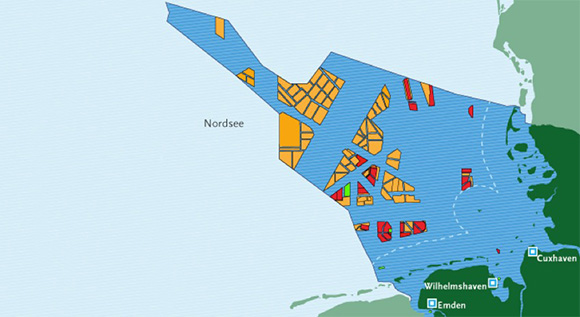Offshore wind power in Germany set to triple in 2015
Following last year’s reform of the Renewable Energy Sources Act and the improvements made to the investment and operating framework, the number of offshore wind farms has seen a steep rise. To find out where exactly wind power is being harvested in Germany, please see the Ministry’s interactive maps, which are now available on the website.
 © Federal Ministry for Economic Affairs and Energy
© Federal Ministry for Economic Affairs and Energy
In early August, the Butendiek wind farm located 32 km off the German North Sea island of Sylt started to generate electricity and feed it into the German grid. The wind farm consists of 80 new installations with a combined capacity of 288 MW. According to the operator, the level of noise emissions measured during the installation was the lowest ever to be recorded. The installation process was completed in time and on budget. On 2 September 2015, the Global Tech I wind farm also began to operate. This wind farm is made up of 80 installations whose combined capacity is a massive 400 MW. As it is situated further offshore than any other wind farm, the wind farm is expected to be able to operate at full load for around 4,000 hours per year, which is about twice as much as an onshore wind farm could provide. Also inaugurated at the beginning of this month was the Trianel wind farm off the shore of Borkum (capacity of 200 MW), with the opening of the Baltic 2 also to take place in September (288 MW).
Offshore capacity added in 2015: 422 new installations within the first semester
The Butendiek, Trianel, Global Tech I, and Baltic 2 wind farms form part of a wider positive trend reflected in the mid-year statistics published by the Working Group on offshore wind power. The expansion of offshore renewable capacity is progressing well, Another 422 installations with a combined capacity of 1.77 GW were added within the first six months of this year, bringing up Germany’s total offshore capacity in the North Sea and the Baltic Sea to 2.78 GW. This figure is equivalent to the electricity needs of around 3 million households.
The sector is expecting additional offshore capacity to become available in the second semester of 2015. In its latest report on the maritime economy, the German Government projects the total offshore capacity being operated in German territorial waters in the North Sea and the Baltic Sea to reach 3.3 GW by the end of this year – enough to feed in 12 terawatt hours of electricity into the grid. This would mean a threefold increase in Germany’s offshore wind power capacity within just a year. It would also mean that half of the 6.5 GW target of offshore capacity being operated has already been met.
New information services at erneuerbare-energien.de
For a good overview of existing offshore wind farms, projects that are in the planning and construction phases, and grid links, please consult the information pages of the Federal Ministry for Economic Affairs and Energy at www.erneuerbare-energien.de (in German only). You will find each of the existing wind farms, all of the projects that have been approved, and the ones under construction marked on a map showing their exact location. Click on the project to see its main operational indicators. Click here to access the interactive maps.
Renewable Energy Export Initiative at the HUSUM Wind fair
Not only is offshore wind power a vital pillar of our energy transition, it is also a key sector for economic growth, not least for Germany’s coastal regions. The plans for an expansion of offshore wind power in Germany, but also in other countries bordering the North Sea or the Baltic Sea, such as the UK, Denmark, and the Netherlands, have opened up new economic prospects for German manufacturers of wind-powered installations and their suppliers, for the shipbuilding industry, maritime service, and for other sectors as well.

